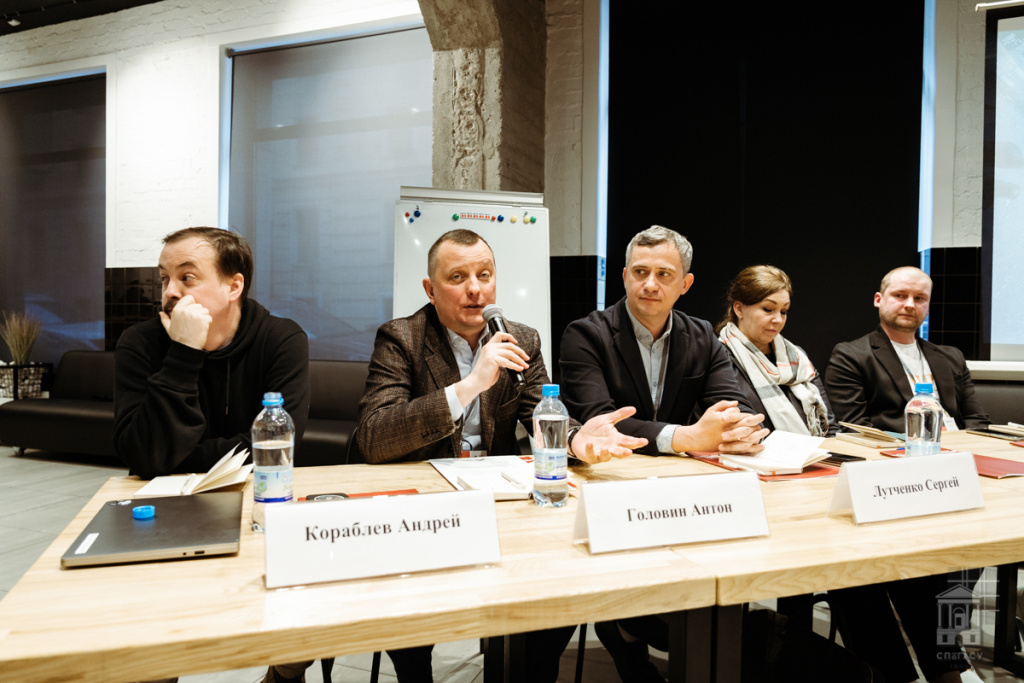 Meeting participants
Meeting participants
On 22 April, the Research Institute for Sustainable Development in Construction (NIIURS), with the support of the St Petersburg State University of Architecture and Civil Engineering and the year-round mountain resort Rosa Khutor, opened the III All-Russian architectural open creative competition for students of architectural universities in Russia “Green tourist shelter in a natural area” " On this day, as part of the Architectural Seasons at SPbGASU, at a round table, experts discussed the sustainable development of the tourism industry, answered questions from students and focused their attention on the details that need to be taken into account when developing competitive facilities.
 Oleg Fedorov, Vera Burtseva and Dmitry Kolosov
Oleg Fedorov, Vera Burtseva and Dmitry KolosovDirector for Sustainable Development of the Rosa Khutor resort, moderator of the meeting Dmitry Kolosov clarified that the domestic tourism industry in Russia is actively developing, and the task of specialists is to ensure that, on the one hand, they offer tourists a comfortable holiday in nature, and on the other hand, a harmonious relaxation facilities for their temporary stay in the environment. In this case, it is necessary to take into account economic feasibility and legal requirements.
“The competition will allow participants to practice developing concepts for temporary facilities for tourism purposes, to study the specifics of the tourism industry and its huge potential, and for us, the organizers, to gain fresh ideas for creating an appropriate environment and increasing the flow of tourists,” emphasized Dmitry Kolosov.
According to Oleg Fedorov, Deputy Dean of the SPbGASU Faculty of Architecture for Career Guidance Counceling, SPbGASU students took part in previous seasons of the competition and gained experience in developing similar concepts and increased their interest in small facilities, including those in specially protected areas. In addition, the competition gives them the opportunity to consolidate in practice the knowledge gained starting from the first year.
 Andrey Korablev, Anton Golovin, Sergey Lutchenko, Daria Boytsova and Pavel Elizarov
Andrey Korablev, Anton Golovin, Sergey Lutchenko, Daria Boytsova and Pavel Elizarov
“The buildings in question are compact and require minimizing their negative impact on the environment. Thus, students have the opportunity to take a more scrupulous approach to the development of design characteristics in order to successfully perform at the competition, and therefore increase the chance of realizing their projects thanks to partners,” noted Oleg Fedorov.
To increase the chances of implementing projects, NIIURS Director Vera Burtseva suggested first considering the future facility from the point of view of sustainable development.
“We must create not just a technological, energy-efficient, nature-friendly facility, but also a facility that meets the needs of a certain category of tourists. And these requests need studying; for example, if a potential client wants to relax in a typical Russian hut, but at the same time be able to connect a USB, then this is exactly what should be offered to him. In other words, it is necessary to assess the potential consumer audience and think through the combination of identity and comfort,” explained Vera Burtseva.
First Deputy Chairman of the Urban Development Policy Committee, the Chief Architect of the Leningrad Region Sergey Lutchenko noted that the tourism industry is actively developing, and regional executive authorities are looking for ways to balance the development of the necessary infrastructure that will attract tourists even to remote areas of the region, including specially protected areas, with no harm to the environment.
“The Leningrad region is implementing the priority regional project “Trail 47”, a new approach to creating equipped tourist trails in natural areas. Experience has already revealed significant socio-economic effects for our region: more than 40 environmental routes have been created within the boundaries of specially protected natural areas. But they, like other sites, require the development of the necessary infrastructure,” said Sergey Lutchenko.
The chief architect believes that for further effective development it is advisable to classify tourism facilities according to current areas: for example, pilgrimage, military-patriotic, environmental.
Senior lecturer at the SPbGASU Department of Architectural Design Daria Boytsova noted that tourists can pursue different goals: for example, a certain type of recreation is participation in a particular event. That is, tourism is always interconnected with some activity. “In this regard, housing facilities are part of the tourism ecosystem. Therefore, it is more appropriate to develop not a universal module, but a facility for a specific place with its own history,” she believes.
Vice-President of the Union of Architects of St Petersburg Anton Golovin believes that thoughtful solutions and the creation of comfortable spaces will help avoid spontaneous development of tourist places.
The presentation of successful concepts for recreational areas and tourist facilities was held by the owner of the architectural bureau "TOBE architects" Andrey Korablev and the architect of the bureau "ZOV.architect" Pavel Elizarov.
“Architects are ready to create and implement popular projects. However, the situation is complicated by the fact that a third of the costs come from transporting construction materials. To optimize costs, it would be good to disperse production throughout the country,” suggested Pavel Elizarov.
To recall, the competition participants are invited to develop the placement of a facility (shelter, hut, field station, winter hut, etc.) in space and a solution for the adjacent territory (general plan) in any natural area with a pronounced relief and taking into account climatic factors. The results of the competition will be announced from 1 to 14 October, 2024.